 |
| May 24, 2016 | Volume 12 Issue 20 |
Mechanical News & Products
Designfax weekly eMagazine
Archives
Partners
Manufacturing Center
Product Spotlight
Modern Applications News
Metalworking Ideas For
Today's Job Shops
Tooling and Production
Strategies for large
metalworking plants
How ball spline coatings enhance performance and extend component life
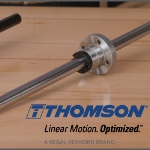 According to Thomson, "Precision ball splines have gained popularity as an ideal choice for applications that require low-friction linear and rotary motion. These components, which utilize a single splined shaft, enable complex movements in multiple directions." But how do you keep these ball splines performing at their peak for longer? Coatings can do the trick, and Thomson has three of them: black oxide, hard chrome plating, and nickel plating. Learn more about these coatings and which one makes the most sense for your precision ball spline solution.
According to Thomson, "Precision ball splines have gained popularity as an ideal choice for applications that require low-friction linear and rotary motion. These components, which utilize a single splined shaft, enable complex movements in multiple directions." But how do you keep these ball splines performing at their peak for longer? Coatings can do the trick, and Thomson has three of them: black oxide, hard chrome plating, and nickel plating. Learn more about these coatings and which one makes the most sense for your precision ball spline solution.
View the video.
Key factors for ball screw applications
 Learn the six key factors that should be considered when specifying ball screw assemblies in motion control applications. PCB Linear gathered a panel of experts in the field of linear motion to concentrate on this important topic -- particularly when it comes to the company's new miniature ball screw product line. Learn about precision and accuracy, orientation, speed and acceleration, duty cycle, linear motion travel, and load capacity. Podcast available too.
Learn the six key factors that should be considered when specifying ball screw assemblies in motion control applications. PCB Linear gathered a panel of experts in the field of linear motion to concentrate on this important topic -- particularly when it comes to the company's new miniature ball screw product line. Learn about precision and accuracy, orientation, speed and acceleration, duty cycle, linear motion travel, and load capacity. Podcast available too.
Read the PCB Linear blog.
3D printer uses pellet extrusion system instead of filament
 The latest addition to 3D Systems' industry-leading portfolio of EXT Titan Pellet systems is the EXT 800 Titan Pellet. With a build volume of 800 x 600 x 800 mm, this thermoplastics 3D printer harnesses the speed, reliability, and efficiency of the company's large-format pellet systems in a more compact unit with lower upfront investment. Use this machine to fabricate more modestly sized functional prototypes, tooling, fixtures, sand casting patterns, thermoforming molds, and end-use parts. Markedly faster than competing FFF and FDM printers, and up to 10X reduced material costs compared to filaments.
The latest addition to 3D Systems' industry-leading portfolio of EXT Titan Pellet systems is the EXT 800 Titan Pellet. With a build volume of 800 x 600 x 800 mm, this thermoplastics 3D printer harnesses the speed, reliability, and efficiency of the company's large-format pellet systems in a more compact unit with lower upfront investment. Use this machine to fabricate more modestly sized functional prototypes, tooling, fixtures, sand casting patterns, thermoforming molds, and end-use parts. Markedly faster than competing FFF and FDM printers, and up to 10X reduced material costs compared to filaments.
Learn more.
Test your knowledge: High-temp adhesives
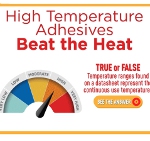 Put your knowledge to the test by trying to answer these key questions on how to choose the right high-temperature-resistant adhesive. The technical experts from Master Bond cover critical information necessary for the selection process, including questions on glass transition temperature and service temperature range. Some of the answers may surprise even the savviest of engineers.
Put your knowledge to the test by trying to answer these key questions on how to choose the right high-temperature-resistant adhesive. The technical experts from Master Bond cover critical information necessary for the selection process, including questions on glass transition temperature and service temperature range. Some of the answers may surprise even the savviest of engineers.
Take the quiz.
World's first current-carrying fastening technology
 PEM® eConnect™ current-carrying pins from Penn-Engineering provide superior electrical connections in applications that demand high performance from internal components, such as automotive electronics. This first-to-market tech provides repeatable, consistent electrical joints and superior installation unmatched by traditional fastening methods. Features include quick and secure automated installation, no hot spots or poor conductivity, and captivation options that include self-clinching and broaching styles.
PEM® eConnect™ current-carrying pins from Penn-Engineering provide superior electrical connections in applications that demand high performance from internal components, such as automotive electronics. This first-to-market tech provides repeatable, consistent electrical joints and superior installation unmatched by traditional fastening methods. Features include quick and secure automated installation, no hot spots or poor conductivity, and captivation options that include self-clinching and broaching styles.
Learn more about eConnect pins.
New flat quarter-turn clamping fastener
 IMAO Fixtureworks has expanded its One-Touch Fastener lineup to include a new quarter-turn clamping fastener that features an innovative flat design and is ideal for clamping in limited spaces. The QCFC flat quarter-turn fastener features a recessed body that protrudes only 2 mm from the mounted surface, a knob that rests flush inside the body, visible ON and OFF markings for safety, and an audible click when fully turned to clamped or unclamped position.
IMAO Fixtureworks has expanded its One-Touch Fastener lineup to include a new quarter-turn clamping fastener that features an innovative flat design and is ideal for clamping in limited spaces. The QCFC flat quarter-turn fastener features a recessed body that protrudes only 2 mm from the mounted surface, a knob that rests flush inside the body, visible ON and OFF markings for safety, and an audible click when fully turned to clamped or unclamped position.
Learn more.
Bellows and disc couplings with higher torque capacity
 Ruland Manufacturing now offers bellows and double disc couplings with bore sizes up to 1-3/4 in. or 45 mm for use in systems with torque up to 1,400 in.-lb (158 Nm). High-torque applications in precision semiconductor, solar, conveyor, and factory automation applications often use these shaft sizes. Ruland disc and bellows couplings accommodate all forms of misalignment, are zero-backlash, and have a balanced design for reduced vibration at speeds up to 10,000 rpm.
Ruland Manufacturing now offers bellows and double disc couplings with bore sizes up to 1-3/4 in. or 45 mm for use in systems with torque up to 1,400 in.-lb (158 Nm). High-torque applications in precision semiconductor, solar, conveyor, and factory automation applications often use these shaft sizes. Ruland disc and bellows couplings accommodate all forms of misalignment, are zero-backlash, and have a balanced design for reduced vibration at speeds up to 10,000 rpm.
Learn more.
Simplify your designs with slewing ring bearings
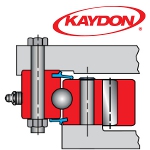 According to Kaydon Bearings, "A slewing ring bearing has rolling elements designed to create a reactive moment within the bearing's dimensions envelope to oppose applied (overturning) moment load," so you can use one bearing instead of two, reducing the height requirements, and even improve performance. Slewing ring bearings can also simplify a drive system by utilizing gear teeth on the inner or outer race. Learn all about slewing ring bearings in this informative article.
According to Kaydon Bearings, "A slewing ring bearing has rolling elements designed to create a reactive moment within the bearing's dimensions envelope to oppose applied (overturning) moment load," so you can use one bearing instead of two, reducing the height requirements, and even improve performance. Slewing ring bearings can also simplify a drive system by utilizing gear teeth on the inner or outer race. Learn all about slewing ring bearings in this informative article.
Read the Kaydon whitepaper.
Jet valve for ultra-small dispensing
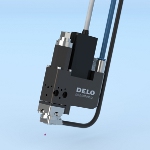 DELO's DELO-DOT PN5 LV pneumatic jet valve is designed for micro-dispensing low-viscosity adhesives and other media in miniaturized applications. Thanks to its compact design, it also requires very little space to install in production systems. Interchangeable nozzles with different diameters and a flexible, adjustable plunger stroke ensure precise and reliable applications at different droplet sizes. Volumes of as low as 1 nl can be achieved, which corresponds to droplet diameters of 250 µm or less.
DELO's DELO-DOT PN5 LV pneumatic jet valve is designed for micro-dispensing low-viscosity adhesives and other media in miniaturized applications. Thanks to its compact design, it also requires very little space to install in production systems. Interchangeable nozzles with different diameters and a flexible, adjustable plunger stroke ensure precise and reliable applications at different droplet sizes. Volumes of as low as 1 nl can be achieved, which corresponds to droplet diameters of 250 µm or less.
Learn more.
Stainless steel constant-torque flush-mount hinge
 Southco has introduced a flush-mount version of its popular and durable E6 constant-torque hinge. Its low-profile, corrosion-resistant package makes it an ideal solution for maximizing security, longevity, and aesthetics. It offers high torque for demanding applications while maintaining its low profile. Lots of uses.
Southco has introduced a flush-mount version of its popular and durable E6 constant-torque hinge. Its low-profile, corrosion-resistant package makes it an ideal solution for maximizing security, longevity, and aesthetics. It offers high torque for demanding applications while maintaining its low profile. Lots of uses.
Learn more.
Claw vacuum pump for industrial applications
 Vacuum expert Leybold has added a new model to its proven CLAWVAC dry claw vacuum pump series: the CLAWVAC CP B. This innovative, rough vacuum pump, designed for robust processes including food processing, material handling, and environmental industries, is powerful, energy efficient, and easy to clean. The intuitive handling of this unit is mainly due to its functional design, which features a pair of claws that rotate in the cylinder with no contact or wear. Its separate gearbox prevents oil contamination. The design ensures short downtimes and long service intervals: 20,000 hr between oil changes and up to 48,000 hr between general overhauls.
Vacuum expert Leybold has added a new model to its proven CLAWVAC dry claw vacuum pump series: the CLAWVAC CP B. This innovative, rough vacuum pump, designed for robust processes including food processing, material handling, and environmental industries, is powerful, energy efficient, and easy to clean. The intuitive handling of this unit is mainly due to its functional design, which features a pair of claws that rotate in the cylinder with no contact or wear. Its separate gearbox prevents oil contamination. The design ensures short downtimes and long service intervals: 20,000 hr between oil changes and up to 48,000 hr between general overhauls.
Learn more.
DualVee linear guides and tracks used in warehousing
 See how Bishop-Wisecarver's DualVee® motion tech can add huge benefits to warehousing operations. This video highlights two applications: a manual storage and retrieval system and an automated storage and retrieval system of long aerospace-grade carbon fiber in sub-zero temps. Patented DualVee guides and tracks keep operations running smoothly.
See how Bishop-Wisecarver's DualVee® motion tech can add huge benefits to warehousing operations. This video highlights two applications: a manual storage and retrieval system and an automated storage and retrieval system of long aerospace-grade carbon fiber in sub-zero temps. Patented DualVee guides and tracks keep operations running smoothly.
View the video.
Build-to-order knobs and hand hardware
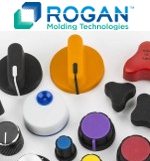 Rogan Corp.'s innovative use of two-shot plastic injection and insert molding has been providing customers with high-quality plastic clamping knobs, levers, and control knobs for almost 90 years. Rogan offers concurrent engineering, product design, and assistance in material selection to ensure customer satisfaction for standard or customized parts, with a focus on cost optimization and on-time delivery. Custom colors, markings, decorative inlays, or engineered materials to meet special requirements, such as adding extra strength or utilizing flame-retardant material, are all offered.
Rogan Corp.'s innovative use of two-shot plastic injection and insert molding has been providing customers with high-quality plastic clamping knobs, levers, and control knobs for almost 90 years. Rogan offers concurrent engineering, product design, and assistance in material selection to ensure customer satisfaction for standard or customized parts, with a focus on cost optimization and on-time delivery. Custom colors, markings, decorative inlays, or engineered materials to meet special requirements, such as adding extra strength or utilizing flame-retardant material, are all offered.
Learn more.
Slewing ring bearing made of wood and plastic
 The PRT-02-30-WPC slewing ring bearing is another step forward by igus toward integrating renewable raw materials into industrial production. Made of 50% wood and 50% high-performance plastics, the cost-effective and lubrication-free slewing ring bearing balances strength and durability with a proven low CO2 footprint. The materials incorporate solid lubricants, making the new slewing ring bearing smooth running and maintenance-free.
The PRT-02-30-WPC slewing ring bearing is another step forward by igus toward integrating renewable raw materials into industrial production. Made of 50% wood and 50% high-performance plastics, the cost-effective and lubrication-free slewing ring bearing balances strength and durability with a proven low CO2 footprint. The materials incorporate solid lubricants, making the new slewing ring bearing smooth running and maintenance-free.
Learn more.
Flex Locators for quick fixture changeover
 Flex Locators from Fixtureworks are designed for quick changeover of small and large fixtures, automation components, and more. They are ideal for applications that require frequent disassembly, providing excellent repeatability for locating and clamping in a single operation. Manual and pneumatic versions are available. Just turn the handle, knob, or screw!
Flex Locators from Fixtureworks are designed for quick changeover of small and large fixtures, automation components, and more. They are ideal for applications that require frequent disassembly, providing excellent repeatability for locating and clamping in a single operation. Manual and pneumatic versions are available. Just turn the handle, knob, or screw!
View the video.
Can your rooftop handle solar panels? Sandia tests say 'probably so'
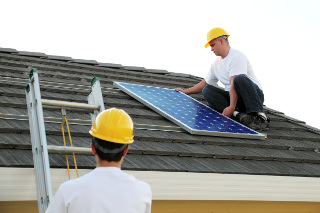
An analysis of rooftop structural strength by Sandia National Laboratories provides a new tool in evaluating homes for solar installations. [Photo courtesy: Sandia National Laboratories]
Most U.S. rooftops in good repair can take the weight of solar photovoltaic (PV) systems. That's the conclusion of a three-year study by a research team led by Sandia National Laboratories.
"There is a misperception in the building industry that existing residential rooftops lack the strength to carry the weight load of rooftop solar photovoltaic installations," said Sandia structural engineer Steve Dwyer. "Most existing well-built wooden rooftops can support PV system loads."
Sandia took on the job of analyzing rooftop structural strength to address concerns raised in the U.S. Department of Energy's (DOE) Solar America Cities program. The agency named 25 cities to promote adoption of solar technology at a comprehensive, local level through photovoltaics.
At least one city reported the primary barrier to solar was the difficulty and cost of obtaining construction permits for rooftop solar installations because of structural issues. "I couldn't believe it was a problem," said Dwyer, who led the Sandia test team. "Solar PV systems represent little additional weight, and roofs are very strong."
He said many code officials aren't familiar with solar technology and lack the training to evaluate how a solar PV system might affect roof structure. So they bring structural engineers into the permitting process, adding time and money for the system owner and the solar contractor. Often, they then deny engineering certification for solar PV installations on wood roofs, declaring the structures too weak.
Load-bearing capacity is several times higher
In two, first-of-their-kind studies funded by DOE's SunShot Initiative -- which seeks to make solar energy cost competitive with other energy sources by the end of the decade -- and conducted in partnership with the University of New Mexico (UNM), Sandia stressed wood rooftop structures to the point of failure and compared the data with allowable loads identified in the International Residential Code and the National Design Standard.
They concluded the actual load-bearing capacity for residential rooftop structural systems is several times higher than the calculated values.
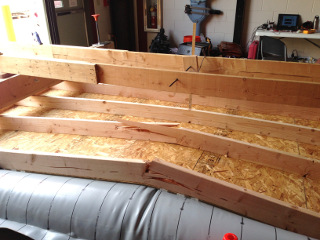
In a University of New Mexico lab, roofs were built and stressed to the breaking point to show the solar permitting community how strong they are. The tests were done by Sandia National Laboratories in partnership with UNM. [Photo courtesy: Sandia National Laboratories]
Sandia hopes engineers and permitting officials will use the results when they make decisions about rooftop strength and solar PV applications, increasing the number of safe, cost-effective rooftop solar PV installations.
"Safety is a crucial factor in building codes and must be considered when there is any change to a structure," Dwyer said. "Understanding how weight loads affect the structural integrity of a roof is important to homeowners, code officials, solar installers, and builders. These results provide a new tool and set of data for consideration in evaluating rooftops for solar PV installations."
The roof acts as a whole
Dwyer said engineers doing rooftop structural analysis often calculate stresses on the basis of an individual beam, rafter, or truss. That approach assumes each component of the structure acts alone. "It fails to consider the rooftop system as a whole or consider the load-sharing or load redistribution effects of a roof system," he said. "The result is a conservative analysis that does not accurately represent the roof's ability to support a PV installation. It's not a fair assessment."
And he said engineering evaluations are not universally applied across cities and states. "Some do them, and some don't," he said. "Local governments pick and choose what they accept. Not everybody uses the same method, so it can be difficult for solar installers and residents to know what to expect. All these issues have posed serious challenges to the solar industry."
Dwyer said the Sandia team realized building codes won't change, so they tackled the problem by building some roofs, breaking them, and showing the permitting community just how strong a roof is. Starting about three years ago, the team built different roof sizes in a UNM lab.
"We did a lot of testing," Dwyer said. "First, we wanted to be sure we were on the right track. We thought, 'OK, the engineers are not giving credit for load sharing,' so we tested a two-by-four, broke it in half, then nailed a piece of sheeting to it to see if it added strength. It did, 35 percent with nailing and 74 with gluing. We were on the right track."
They built scaled versions of roofs in different lengths with five rafters or trusses 8 to 20 feet long and applied a uniform load over the whole thing. "We used air as the load," Dwyer said. "We built bladders of different sizes and used them to put pressure on top of the roof by filling them with air at up to 144 pounds per square foot. We broke every size rafter and the more commonly used trusses, five sets of each."
On average, the rafter-based tests demonstrated a 330 percent excess load-bearing capacity compared to values computed in the National Design Standard. "This suggests that current rooftop structural evaluations are overly conservative in evaluating the ability of roofs to support additional loading from solar PV installations," Dwyer said. "A well-built home that meets local building standards and has not been adversely modified or damaged should have enough load-bearing capacity to support a roof-mounted PV system."
You can learn more about Sandia's energy programs here.
Source: Sandia
Published May 2016
Rate this article
View our terms of use and privacy policy


